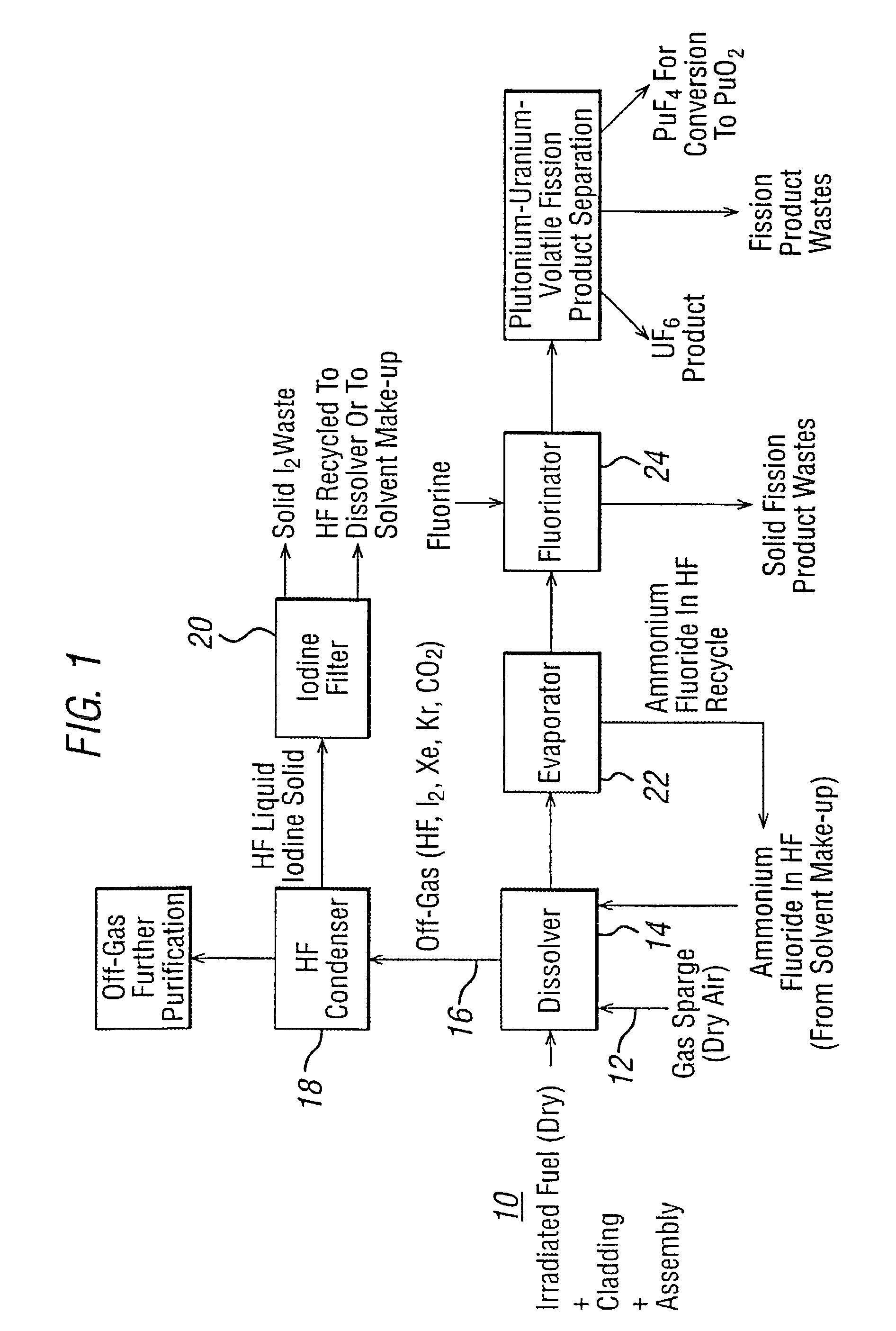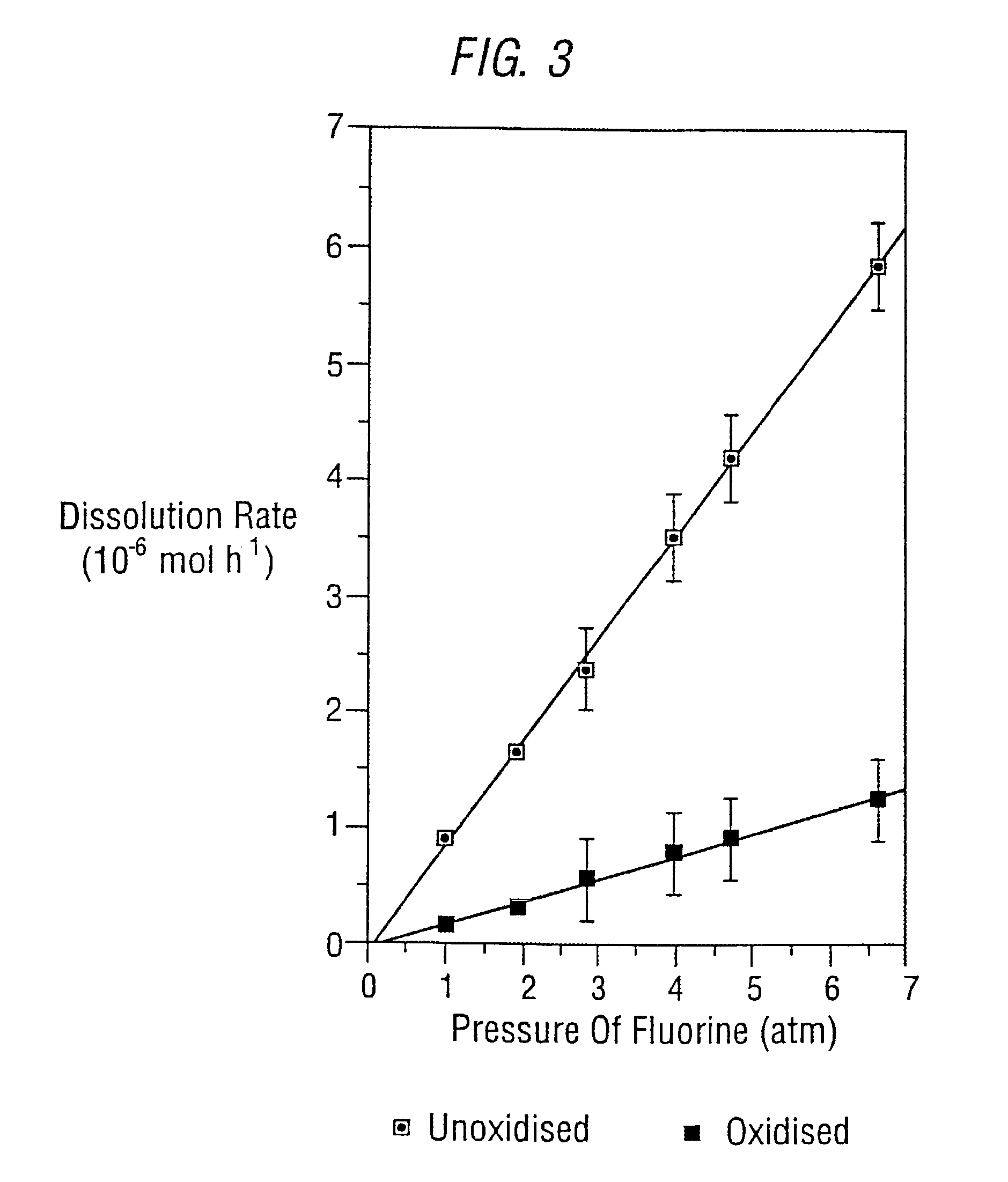Method of separating uranium from irradiated nuclear fuel
a technology of irradiation and nuclear fuel, which is applied in the field of separating uranium, can solve the problems of low waste volume generated, and achieve the effects of reducing waste volume, reducing waste volume, and easy recycling
- Summary
- Abstract
- Description
- Claims
- Application Information
AI Technical Summary
Benefits of technology
Problems solved by technology
Method used
Image
Examples
example 1
Variation of the NH4F: ZIRCALOY Molar Ratio
[0044]A series of experiments were performed in which either unoxidised or oxidised ZIRCALOY were allowed to react in a variety of molar ratios with ammonium fluoride. The ‘oxidised’ material is a simulation of material present after exposure to the extreme conditions inside a nuclear reactor.
[0045]The reaction of the ZIRCALOY was independent of the NH4F concentration. A series of experiments were carried out to establish whether any variation in rate associated with changes in the NH4F: ZIRCALOY molar ratio was actually a concentration effect. In these reactions, NH4F and ZIRCALOY were reacted in a x:y ratio solvated in either 5 or 10 cm3 of anhydrous HF (AHF) under 2.86 atmospheres of fluorine gas. In both sets of experiments, the rates of ZIRCALOY dissolution were identical indicating that the variation in rate is associated with the relative molar ratios and is not associated with a variation in the concentration of NH4F in solution. Ho...
example 2
Variation of F2 Pressure
[0046]A series of experiments investigating the effect on dissolution rate of the variation of F2 were performed. FIG. 3 shows the results, which indicate that the dissolution rate is linearly dependent on F2 pressure. However, this interpretation of the results does not take into account the effective F2 concentration in solution or the fact that the partial pressure of fluorine above the solution will decrease as the reaction proceeds. The maximum measured rate of dissolution for unoxidised and oxidised ZIRCALOY under these conditions was 5.80×10−6 mol hr−1 and 1.09×10−6 mol hr−1 which corresponds to 0.53 mg hr−1 and 0.01 mg hr−1 respectively, at 6.63 atm F2 pressure and a 2:1 molar ratio of NH4F: ZIRCALOY. The rate of dissolution of oxidised ZIRCALOY was again slower than that for the unoxidised ZIRCALOY, approximately 5.2 times.
[0047]An idea of the attainable dissolution rates can be obtained if the two maximum measured dissolution rate are considered tog...
example 3
Variation of the NH4F: Uranium Dioxide Molar Ratio
[0049]A series of experiments on the reaction of uranium dioxide with NH4F / F2 / AHF were performed, where the molar ratios of NH4F: UO2 were varied. As was seen in the reaction of ZIRCALOY in Example 1, the reaction of uranium dioxide with NH4F, is also independent of the concentration of NH4F. An identical procedure to that used for Example 1 for ZIRCALOY was applied to uranium dioxide.
[0050]FIG. 4 shows the dissolution rates of UO2 in the experiments performed with increasing molar ratios of NH4F: UO2. The plot shows that the dissolution rate is approximately quadratically dependent on the molar ratio of NH4F: UO2, as observed for ZIRCALOY. The maximum measured rate of dissolution achieved for UO2 under these conditions was 1.567×10−4 mol hr−1, which corresponds to 42.32 mg hr−1, at a 6:1 molar ratio NH4F: UO2, and 2.86 atm F2 pressure.
[0051]As was expected the uranium dioxide reacted considerably faster than ZIRCALOY with NH4F / F2 / AH...
PUM
| Property | Measurement | Unit |
|---|---|---|
| Concentration | aaaaa | aaaaa |
| Volatility | aaaaa | aaaaa |
Abstract
Description
Claims
Application Information
 Login to View More
Login to View More - R&D
- Intellectual Property
- Life Sciences
- Materials
- Tech Scout
- Unparalleled Data Quality
- Higher Quality Content
- 60% Fewer Hallucinations
Browse by: Latest US Patents, China's latest patents, Technical Efficacy Thesaurus, Application Domain, Technology Topic, Popular Technical Reports.
© 2025 PatSnap. All rights reserved.Legal|Privacy policy|Modern Slavery Act Transparency Statement|Sitemap|About US| Contact US: help@patsnap.com



